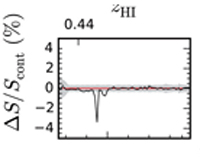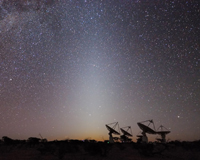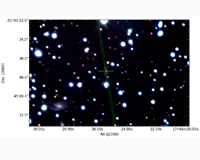ASKAP discovers HI absorption in distant galaxy
6 July 2015
CSIRO's newest radio telescope, ASKAP, has opened a window to a little-explored period of the Universe’s history, by using a special technique to spot a galaxy five billion light-years away. The galaxy was uncovered using the Boolardy Engineering Test Array (BETA) - a functioning telescope used for commissioning the first six ASKAP antennas installed with Mk I phased array feed (PAF) receivers.
Using the 711.5 - 1015.5 MHz band of ASKAP, the team conducted a blind search for the 21cm HI line in a continuous redshift range between z = 0.4 - 1.0. This range has, until now, remained largely explored. An absorption line was detected at z = 0.44 towards the radio source PKS B1740-517, and confirmed by optical spectroscopy to be intrinsic to the early-type host galaxy.
These results would not have been possible without the unique features of the ASKAP telescope and the unique radio-quiet environment offered by the Murchison Radio-astronomy Observatory (MRO).
“At many observatories, this dip would have been hidden by background radio noise, but our site is so radio quiet it stood out clearly,” Dr Allison said, “These latest research findings are demonstrating that ASKAP can do what other telescopes can’t.”
The results are also a great demonstration of the science possible with FLASH (First Large Absorption Survey in HI), one of the ten ASKAP Survey Science Projects that will use the absorption technqiue to find hundreds of galaxies up to ten billion light years away and determine how much hydrogen gas they contain. This information will help astronomers understand why star formation, which is fuelled by hydrogen gas, has dropped off in the Universe since its peak 10 billion years ago.
This is the first of a number of initial science results achieved using ASKAP commissioning data from the Boolardy Engineering Test Array (BETA), and a strong demonstration of the telescope's excellent capability for performing future wide-field surveys for HI absorption at these redshifts. Dr Allison is announcing the discovery today [6 July] at the UK’s National Astronomy Meeting (NAM2015) in Llandudno, north Wales.
The paper that details the discovery is available on arXiv, and for more information, read the press releases from CSIRO, 'We've revealed a galaxy far, far away...' and the Royal Astronomical Society (for NAM2015).
Back to Latest ASKAP News page.



